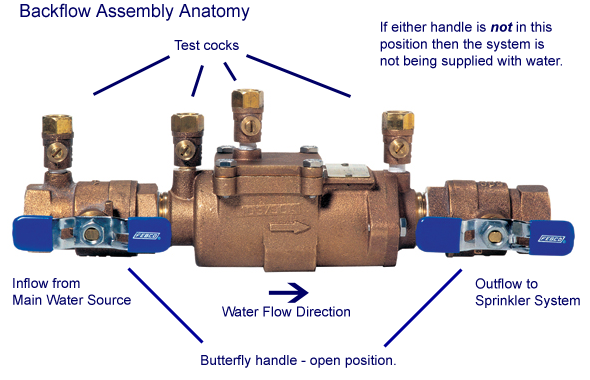Backflow Prevention is a serious Health issue. This device is required to be operational on all automatic sprinkler systems -- It's what prevent our drinking water from being contaminated! It isn't "just" the shut-off valve to your sprinkler water source.
What is a cross-connection?
A physical connection between drinkable water and a liquid or gas that could make the water unsafe to drink. Wherever there is a cross-connection, there is a potential threat to public health from the liquid or gas contaminants.
What is backflow?
Water flowing in the opposite of its intended direction, either from a loss of pressure in the
supply lines or an increase in pressure on the customer’s side.
Common cross-connections:
• Garden hose: Backflow through cross-connections can occur at your home if you leave a garden hose turned on and submerged in a swimming pool, or insert it into your car’s radiator to flush out the antifreeze, or attach it to an insecticide sprayer. That material could siphon back into your drinkable water.
• Private well: Backflow can also occur if a pump supplied from an untreated water supply, such as a private well, were connected to the drinkable water supply. The untreated water could be pumped into the drinkable water supply which serves your home and the public water system.
• Lawn sprinkler system: TCEQ regulations require that all lawn sprinkler systems be connected through a mechanical backflow prevention assembly—without which, the stagnant water from the sprinkler system
could be drawn into the drinkable water supply for your home.
How can backflow be prevented?
Backflow into a potable-water system can be prevented using an assembly approved by the water supplier, or a physical separation between the water supply and a potential source of pollution. The water supplier determines the type of backflow-prevention assembly required, based on the existing or potential degree of hazard. The TCEQ requires testing of all backflow prevention assemblies at time of installation, by a TCEQ licensed tester. Backflow-prevention assemblies installed to protect against health hazards must be tested annually.
How can I find out more information about backflow?
For more information about backflow and cross connection control, visit www.tceq.state.tx.us/goto/cc .
A physical connection between drinkable water and a liquid or gas that could make the water unsafe to drink. Wherever there is a cross-connection, there is a potential threat to public health from the liquid or gas contaminants.
What is backflow?
Water flowing in the opposite of its intended direction, either from a loss of pressure in the
supply lines or an increase in pressure on the customer’s side.
Common cross-connections:
• Garden hose: Backflow through cross-connections can occur at your home if you leave a garden hose turned on and submerged in a swimming pool, or insert it into your car’s radiator to flush out the antifreeze, or attach it to an insecticide sprayer. That material could siphon back into your drinkable water.
• Private well: Backflow can also occur if a pump supplied from an untreated water supply, such as a private well, were connected to the drinkable water supply. The untreated water could be pumped into the drinkable water supply which serves your home and the public water system.
• Lawn sprinkler system: TCEQ regulations require that all lawn sprinkler systems be connected through a mechanical backflow prevention assembly—without which, the stagnant water from the sprinkler system
could be drawn into the drinkable water supply for your home.
How can backflow be prevented?
Backflow into a potable-water system can be prevented using an assembly approved by the water supplier, or a physical separation between the water supply and a potential source of pollution. The water supplier determines the type of backflow-prevention assembly required, based on the existing or potential degree of hazard. The TCEQ requires testing of all backflow prevention assemblies at time of installation, by a TCEQ licensed tester. Backflow-prevention assemblies installed to protect against health hazards must be tested annually.
How can I find out more information about backflow?
For more information about backflow and cross connection control, visit www.tceq.state.tx.us/goto/cc .
